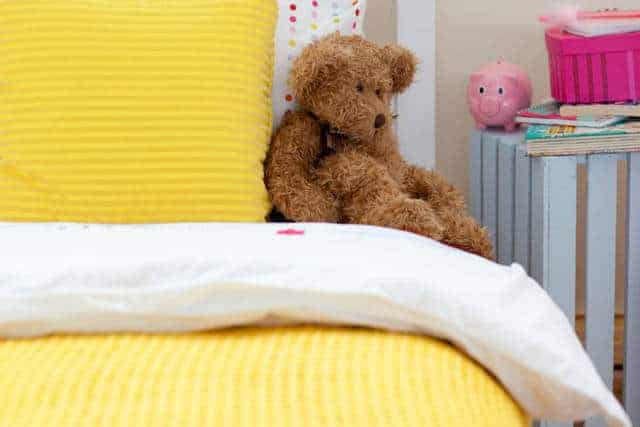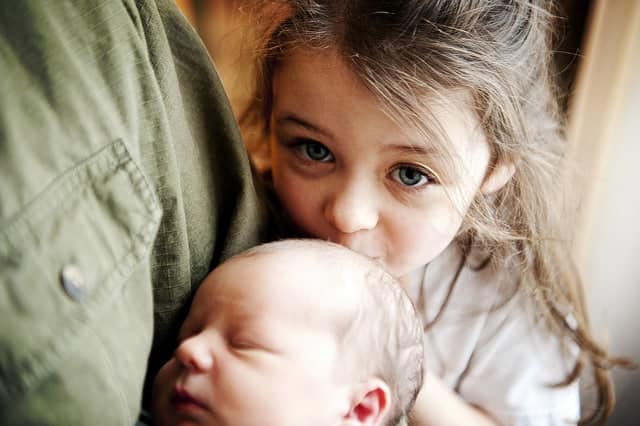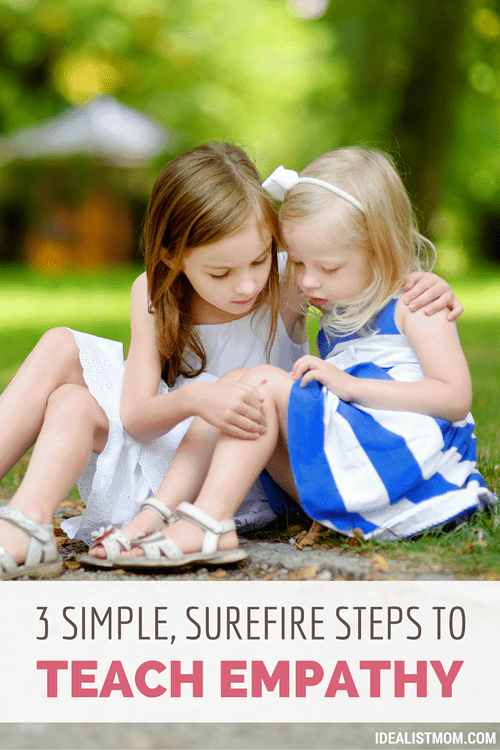Empathy Is Tough to Teach, But Here’s One Trick That Will Boost It
When I’m out in public with my kids and I hear another kid crying or throwing a temper tantrum, I’m not proud of the first thought that crosses my mind.
In the first second after hearing it, my shoulders tense up. I hold my breath. I freeze in the middle of the grocery store aisle, my hands tight on the shopping cart.
Then my mind catches up to the fact that the racket is coming from someone else’s kid, and the relief washes over me. I can breathe, I keep pushing the cart, and I think…
Thank goodness it’s not mine.
I wish my first instinct were to feel empathy for my fellow parent. To flash her the District 12 three-finger salute as a sign of solidarity. But it takes me a few seconds to get there. By the time I do, the moment has passed. We’ve moved to another aisle of the store, or the parent has whisked the kid outside away from prying strangers’ eyes.
Here’s the Problem
I don’t want my kids to grow up to be the kind of people who keep their heads down and ignore others who are in need. If they’re walking down the street and someone yells for help, I want my grown kids to be the type of people who call 911. I want my kids to know that when you’re driving and you see an accident happen, you stop and help – not because it’s the law but because it’s the right thing to do.
One of my top goals as a parent is to help build the empathy muscle in my kids, but my default reaction in those moments isn’t setting a good example.
Some people may tell you that kids aren’t even capable of feeling empathy until the age of six or seven. But it’s not that simple. Kids start developing empathy skills even during infancy, so it’s definitely something you can nurture as a parent.
When my oldest was a toddler, I came across an article about how to develop empathy in kids. That was years ago, so I’ve since lost track of the article. But my top take-away was one deceptively simple tip. The tip is actually the basis of a growing classroom effort designed to nurture empathy in kids. And that one tip completely changed how I react in those moments when someone else’s kid is freaking out.

3 Simple But Powerful Steps for Teaching Empathy
When you’re out and about with your child and you hear another child who’s upset, this is what you do:
- Point out what’s happening. For example, “That kid is crying.”
- Ask your child about it: “How do you think that kid feels right now?” If your child shrugs and can’t think of an emotion, try giving a couple options to choose from, like “Do you think he feels sad or angry?”
- Brainstorm what might help the other child: “What would help that kid feel better?” Wait a few more seconds than you think you should to give your kiddo a chance to think. But if she can’t think of anything, you could try asking: “What helps you feel better when you feel like that?”
We do this every single time we encounter an upset child when we’re out in public. We do it when we’re watching something on TV where a child is upset. We even do it when we’re reading a book together and a child in the story is sad or crying.
I used to feel a little silly for it because it’s one of those things I tend to get neurotic about, like not saying “you’re so smart” or not forcing my kids to hug relatives.
Then last weekend, something opened my eyes to how this approach to teaching empathy has impacted my kids.
Related: We Read 250+ Books About Kindness and Found the Very Best

Does It Work?
We’d just gotten home from running errands, and my eight-month-old Charlotte was overdue for a nap. Translation: Crying, and lots of it.
My toddler Bailey trailed me as I walked into the bedroom to get little Charlie ready for sleep. I had to change her diaper, and Charlie was not a fan of the extra step.
Over my shoulder, Bailey said, “Mama, Charlie’s crying.”
“Mmm, hmm,” I said, trying to break the world record for fastest diaper change as Charlie’s cries went up an octave.
“I think Charlie feels sad.”
I stopped and turned to look at Bailey. The corners of her little mouth pointed down. I smiled, thankful for the seed of empathy sprouting right before my eyes. “Yes, she does feel sad. She’s really tired right now.”
Then I went back to buttoning up Charlie’s onesie, popped her paci back in her mouth, and scooped her up.
“Can I give Charlie a hug to help her feel better?”
I turned back to Bailey again with another smile and blinked to clear my eyes. “Of course you can, sweet girl.”
Related: The Secret to Raising Your Kids to Be Kind (Printable)

Here’s the Best Part
Don’t just take my word for it. That classroom program for teaching empathy that I mentioned earlier? They actually bring babies into the classroom and follow this process to get the school-aged kids thinking about the baby’s feelings. Research on that program shows that using another child’s distress as a tool for developing empathy boosts children’s empathy skills, increases cooperation, and reduces bullying. The children who go through this program for building empathy even experience improved academic outcomes.
So the next time you’re out with your kids and you hear a tantrum in progress, try these three simple steps to build your child’s empathy muscle.
And don’t forget to flash that District 12 sign before it’s too late.
Before you go, get my FREE cheat sheet: 75 Positive Phrases Every Child Needs to Hear
Want More?
To apply this technique while you’re reading books with your child, be sure to check out 50+ Children’s Books About Empathy to Help You Raise Kind Kids.
And if you liked this tip, you’ll probably like this, too: The Secret to Raising Your Kids to Be Kind. (Don’t forget to grab the free printable cards while you’re there!)
Your Turn
Have you tried this approach to teaching empathy? Share in a comment below!



Lovely post. I try to do the same when we’re reading too by asking how the kids think the characters must be feeling and whether other characters are being nice or not. Hmm, books can be a bit black and white. It’s clearly fine to splat someone if they’re the baddy. haha. (P.S I have no idea what District 12 is…I think you need to add a photo of you doing it to explain!)
Hunger Games :)
These are excellent tips, and yes, we also love the idea you have of discussing real life situations with your little ones as they happen. The same idea can apply to videos (movies, TV shows) and books. Of course it helps to start with big-hearted stories that deal with discussion worthy topics such as diversity, gratitude, and citizenship. We offer recommendations for both picture books and chapter books on our website.
What a great real-world idea, thank you Kelly. If we all adopt this approach, the world can’t help but be better for it. Happy new year!
My dad told me that my greatest weakness was too much empathy… I unfortunately agree with that. Empathy is a great thing but I see where it has worked against me at the same time… I try and instill this in my boys as well. My 8 year old and I were watching a movie, which brought me to tears, he looked at me also in tears and hugged me with the strength that no 8 year old should have. I was so proud of him for feeling that way, I think I cried even more…
That’s really a special moment when you see empathy in your boy I think. I love that. I learned a very valuable lesson one day with my 12 year old son. I had also been working on this empathy stuff for some time with both of my boys. Always zoning in on my boys if they spoke loosely about a person. “You don’t know that person, don’t talk about them when you don’t know why they are like that or why they act the way they do.”, I would say many times. One day a woman who looked really rough like she had just got out of prison somehow ended up playing basketball with my son as I had been looking away. When I saw her at first I was kind of alarmed. I told him immediately that it was time to go. He ran up to me and asked, Mom? Can I give that woman my basket ball? I looked over with skepticism but noticed a very sweet little girl with her I had overlooked. My son implored with his eyes a look I never want to forget! Empathy…..My heart hurts even tonight even as I remember the taste of disdainfullness in my attitude that day. That lady was so grateful to be blessed by his thoughtfulness that day. I was torn between being proud of my sob and my heart being smote as hot tears stung my eyes.
* son, Not SOB! LOL!!!
These are great suggestions! It’s really important to me that my kids are empathetic and kind. I love how practical and simple these steps are. PS I am so sorry to hear from your email that you have not received empathy when sharing details of your Cesarean births. I’m a natural birth advocate, but I always want to be careful and respectful of others’ experiences and choices. So that was a good reminder for me.
My kids have the Roots of Emathy program in their school (we live in Canada). It’s a great program, and it’s purpose has served as a good reminder for us grownups too!
Just a point of information for anyone who is curious the classroom program is called roots of empathy. It is really quite amazing to see how attached the class gets to the baby over a year and to see the growth in their empathy as well.
A 2 1/2 year old came into the room I care for children in, he had been out for a couple months. He started crying. The 9 month old, kept watching him, (she loves him!), she smiled at his return, then slowly she started crying too. She was crying for him, I cuddled both until they stopped, she kept looking at him for a sign, when he was done so was she.
I love taking care of children and watching them learn!